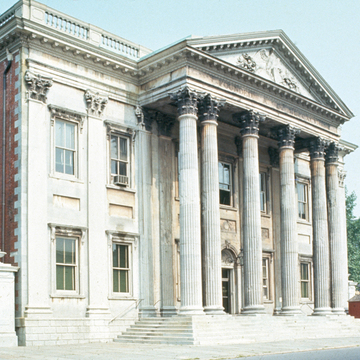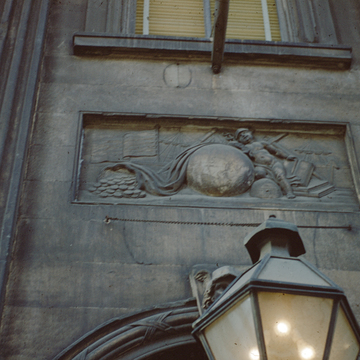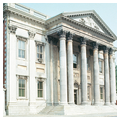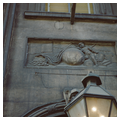Blodget was a New England–born merchant who wrote an early treatise on economics, and after service in the Revolutionary militia found an abiding interest in architecture that was expressed in a competition entry for the United States Capitol, designs for his own hotel in Washington, the scheme for the early classical building for the First Presbyterian Church on High Street depicted in Birch's Views of Philadelphia (1800), and in 1795 the design for this bank. Its stone facade and pediment carried on marble Corinthian columns announced a new element in the political hierarchy of the city—the federal government. The carved wooden eagle by Clodius LeGrand was among the first uses of the national emblem in public architecture and is the oldest surviving example. Benjamin Henry Latrobe, always angling for new work, was not a fan of the design, writing, as Talbot Hamlin includes in his Benjamin Henry Latrobe (1955), “[the] white marble columns of the bank are full of bluish and yellowish veins, but they have, notwithstanding, a very beautiful appearance.
The split between the Federalists, who advocated a strong central government controlling the treasury, and the Democratic-Republicans, who feared such a government, is represented in the history of this building. The construction of the bank marked the ascendancy of Andrew Hamilton and the Federalists; the election of Jefferson resulted in the closure of the bank. Sold to Stephen Girard and renamed the Girard Bank, it became the cornerstone of Philadelphia's private banking industry. In 1901, despite the pending move of city government to Broad and Market streets, the Girard Bank commissioned Windrim to remodel the interior with a glass dome under skylights carried on steel beams. Six years later the bank moved its central offices to Broad Street. The nation in fact needed a central bank and a decade after the closing of the First Bank, the government sponsored a competition that put Latrobe in head-to-head competition with his former student and assistant William Strickland. The building is open by appointment.





